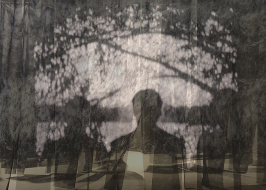Lee Yanor"Suspended"The David Lopatie International Conference Center1
Lee Yanor places us in front of a "delayed" video installation, an overly enriched environment that invites us to gaze directly and simultaneously at wheat fields, the surface of the sea, a full moon night, carpets of anemones, light raindrops — and a human body in motion. These scenes are intertwined with images from the field of science — from laboratories at the Weizmann Institute of Science, primarily in the area of brain research.
The installation, crafted from cut and spread out still photographs printed on strips of silk fabric, serves as a canvas for a projected video film accompanied by a constantly changing soundtrack. This intricate presentation poses a formidable challenge to memory and perception. On one hand, the redundancy and multi-layered nature of the moving images demand "divided attention." On the other hand, each detail within the entirety resists compromise, striving to extract from us the full capacity of observation, analysis, and understanding.
Addressing this rich redundancy involves accepting that there is no singular, sharp, and clear message. Instead, with each repeated viewing, new phenomena emerge, offering fresh insights.
Lee Yanor, born in Haifa, holds a bachelor's degree in photography from Bezalel and a master's degree in art from Paris 8 University. Currently residing and working in Tel Aviv, her works are exhibited in galleries and museums in Israel and around the world, earning her several awards. Her artistic portfolio encompasses abstract and figurative images, through which she “weaves” fragmented narratives that take on subjective associative meanings. The amalgamation of materials and technologies in her installations grants her a unique and boundless perspective, which is encapsulated in a quote by Kazuo Ohno: "There is no up, there is no down. Like moving in an inner space, dancing without moving."
The Artist Residency Program at the Weizmann Institute of Science is supported by the Braginsky Center for the Interface between Science and the Humanities.







